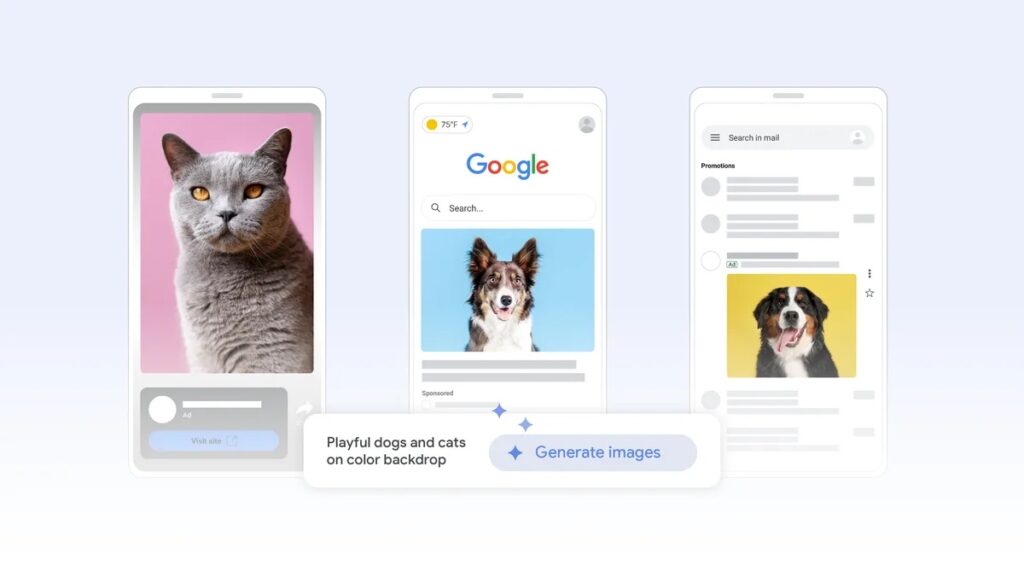Google has recently enhanced its creative tools by integrating generative AI into its Demand Gen campaigns. This new feature offers advertisers sophisticated tools to create custom visuals directly within the ad setup, which could potentially change how brands engage with audiences across Google’s extensive advertising platforms.
Understanding Google’s Demand Generation Campaigns
Google’s Demand Gen campaigns were introduced last year to help advertisers create and convert new demand with visual storytelling on Google’s most immersive and entertainment-focused touchpoints — YouTube, YouTube Shorts, Discover, and Gmail.
Demand Gen is the next generation of Discovery campaigns, and works similarly to traditional social media ads on Facebook, Instagram or TikTok, engaging consumers passively scrolling. As such, an advertiser would typically use their existing social media ad creatives.
Following Google’s latest generative AI release, advertisers can test new creative concepts more efficiently — whether experimenting with new types of images or simply building your creatives from scratch.
Michael Levinson, VP and GM of Social, Local and Vertical Ads
“Google is empowering brands and agencies with more tools to tell a compelling and engaging story in a fast-paced, non-linear digital landscape.
Starting today, generative image tools in Demand Gen will be rolling out to advertisers around the world in English with more languages to come later this year. Powered by Google AI, these tools create stunning, high-quality image assets in just a few steps using prompts provided by you. And, if you have existing images that perform well, you can generate similar options with the new “Generate more like this” feature.”
Incorporation of Generative AI Tools
The integration of generative AI tools into Demand Gen campaigns enables the production of specific visuals for each campaign type, streamlining the creative process and ensuring that content is perfectly tailored to each campaign’s objectives.
These tools leverage AI to generate images from textual prompts provided by advertisers, thereby offering a high degree of customisation in the visual content.
Michael Levinson, VP and GM of Social, Local and Vertical Ads
“Your knowledge and expertise are crucial to help Google AI generate images tailored to your business or client’s needs.
For example, if you have an outdoor lifestyle brand that sells camping gear, use prompts like “vibrantly colored tents illuminated under the Aurora Borealis” to create images that will appeal to those who are shopping for camping trips to Iceland.”
Google latest AI functionality allows marketers to quickly generate and iterate on visual concepts, making the ad creation process both faster and more adaptable to changing market dynamics.
Features Ensuring Uniqueness and Transparency
Google has emphasised the uniqueness of the content generated by these AI tools, ensuring that no two images are identical. This is particularly important in maintaining the distinctiveness of advertising content.
Furthermore, according to Google, all AI-generated images include mechanisms that clearly mark them as AI-generated, maintaining transparency and integrity in how these visuals are presented and perceived.
Customisation and Effective Visual Testing
Google’s new technology also allows advertisers to tailor visuals to meet the specific size and format requirements of different ad types. This capability is crucial for launching targeted and effective promotions.
Google suggests several best practices for effectively using these new AI tools in Demand Gen campaigns:
- Diverse Asset Utilisation: Marketers are encouraged to include various images and videos in each campaign to maximise reach across all potential ad placements. Follow the rule of three—in each ad group, include at least 3 images or videos in each aspect ratio (vertical, square, and landscape) to maximise reach and engagement across all available inventory.
- Quality of Visuals: High-resolution and relevant visuals are recommended to enhance brand perception and motivate user action. The impact of quality visuals on user engagement cannot be overstated—they capture attention and drive interactions more effectively.
- Start by reusing high-performing, inspirational imagery from existing social platforms to save time and showcase your brand at its best. Then, continue optimising your creatives to improve relevance on YouTube and Google.
- Ongoing Optimisation: Google advises adopting a continuous testing and learning strategy. By regularly reviewing the performance of different creative assets, marketers can make informed decisions that optimise their ad strategies and better align with audience preferences.
- Keep an eye on ad strength to understand how well you’ve built your ads to our specs. Once campaigns go live, review the engagement metrics (e.g. click-through rates) in asset reports to identify your top-performing assets, then swap out lower performers with new variations—make sure to aim for both quality and quantity.
Google’s latest release not only potentially enhances the effectiveness of campaigns by ensuring that the visuals are both appealing and relevant but also sets the bar for the likes of Meta, TikTok and LinkedIn et al. for leveraging generative AI in ad creative in 2024.




RECOMMENDED FOR YOU
[STUDY] ChatGPT Powers Work And Life
OpenAI, in collaboration with Harvard economist David Deming, has…
OpenAI, in collaboration with Harvard economist David Deming, has…
LinkedIn Tests New Premium Tools for SMBs
LinkedIn is quietly piloting a new Premium offering designed…
LinkedIn is quietly piloting a new Premium offering designed…
Meta Brings AI Video Editing to Instagram and Meta AI
Meta has launched a new AI-powered video editing feature…
Meta has launched a new AI-powered video editing feature…